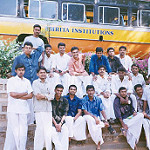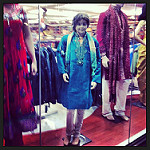Apparel Posted by Nitya on Apr 7, 2017 in Hindi Language
Kurta-pyjama कुर्ता-पजामा, salwar kameez सलवार-कमीज़, churidar-kurta चूड़ीदार-कुर्ता, saari-blouse साड़ी-चोली (choli), lungi-dhoti लुंगी-धोती, … these are all the same right? Not quite.
Western vocabulary has limited terms for the nuanced apparel sported by the broad spectrum of Indian men and women. Most of the above-mentioned outfits would be described in English as tunic, blouse, tights, etc.
However articles of clothing in India not only vary by age, generation, and state or region, but you will find differences between urban and rural populations.
Men’s Clothing:
Modern wear: If you’re getting ready to go to work, or prepping for an interview, you want to look your spiffy best. Today’s modern generation wears trousers and shirts or पतलून-कमीज़.
Traditional wear: कुर्ता-पजामा consists of a longer tunic or कुर्ता. They can be simple and made of cotton, or more elaborate and made of silk, studded with stones, embroidered, etc.
A dhoti धोती (known as vaysh-tee in South India) is basically a long cloth worn to cover the lower half of the body. A धोती is traditional and formal and can be made of silk or cotton. In the olden days (think British Raj), officials wore dhotis as part of a “business suit” that comprised of a crisp cotton shirt and blazer or coat.
These days, a धोती is worn by people in warmer southern states, during weddings, or at home, in lieu of lounge wear, and by members of the older and younger generation alike.
You will also see dhotis worn by priests पुजारी in temples. A धोती is usually white सफ़ेद although some priests will wear saffron भगवा (bhug-waa) or red लाल (laal) dhotis.
Here is a picture collage of the different flavors of men’s clothing.
 A market vendor wearing a lungi. |
 A young man from the era of pre-Independence India. |
|

Build vocabulary, practice pronunciation, and more with Transparent Language Online. Available anytime, anywhere, on any device.











Comments:
A~:
Talking about the different clothes worn for different occasions could be an interesting post! Wedding, temple/mosque, shopping, job interview, typical workday, housewear…